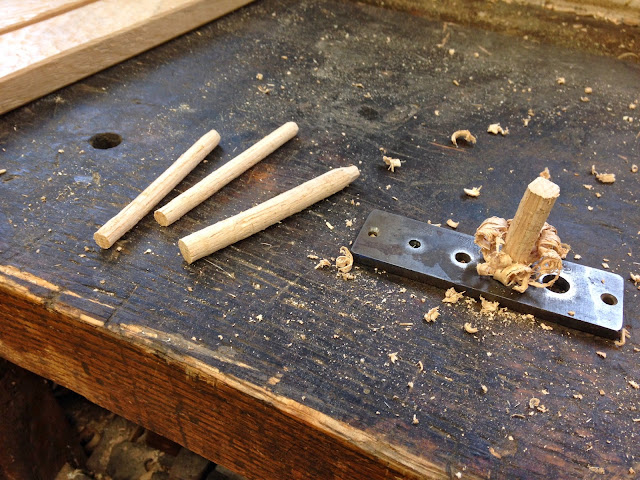Today at the museum some of the wood-loving folks (aka wood butchers) and the blacksmiths had
The Saw Wright, Matt Cianci, come over and do an all day saw sharpening intensive class. He really knows his stuff and enlightened us all on the basics of taking our old beat down reproduction saws and sharpening them to be...well...better.
Matt has a real great method for teaching novice saw sharpeners and breaking down all the steps into bite sized pieces. He first starts by explaining all the theory and saw tooth geometry. We even made a makeshift easel out of our riving break, "The most sturdy easel I have ever seen" according to Matt.
After the theory, we jumped over to the bench and Matt started on some demonstrations.
 |
| No detail is too small when sharpening saws, Matt explains everything. |
We set up some "beater plates" and Matt runs through jointing, shaping, and setting. These are steps that are needed to rehab an abused uneven saw plate into a nice usable sharp saw.
 |
| "The best six bucks I ever spent" Matt says, as he explains making a rake angle guide. |
 |
| Peter Follansbee even stopped by for a lesson, he was sick of "buggering up" his saws. |
Jointing establishes a nice uniform straight tooth-line, or a bellied tooth-line in some large green crosscut saws. This is almost the most important part of sharpening a saw, without it you will slowly wear the teeth into a wavy, usually convex, mess that can be seen on so many vintage handsaws.
 |
| Jointing with "training wheels," we soon ditched the jig and went free hand. |
Next comes shaping, where we even out the teeth and establish the basic geometry of the saws. We started on Rip saw teeth, because they are much easier to file...working tooth by tooth, and focusing only on slope and rake.
 |
| Doing some practice shaping on the "beater" saw plate. By the way, the Gramercy Saw Vice is incredible. |
Matt then explains the many ways that have been used to put set into the teeth. Hammer with setting block, saw wrest, and pliers type saw sets. He shows us his really nice pistol grip saw sets (Stanley 42x) and takes a look over and approves the ones we have for our use at the museum (APEX pattern generics). He shows us the proper use of the pliers sets...which is much easier and faster than I had imagined.
 |
| The Stanley 42x is a sweet tool, it clamps the saw plate, and then engages the anvil plunger to induce the set. |
We also played around with a saw wrest that Matt spotted hanging over our workbench. He pointed out that most people use this tool incorrectly. The correct use is to place the slot above the gullets, spanning two teeth, and then twisting the wrest so that one tooth is set in one direction while the other tooth is set in the opposite direction. Using this method for set is a lot more uncontrollable than the pliers type sets...but it is an older method...so more research needs to be done to see if this is what we should be using. For the time being we are sticking with pliers sets, just for the ease of use and consistency while refining our sharpening skills.
 |
| I had no idea that this tool was a saw wrest, but it is a pretty interesting solution to putting set into a saw. |
Time to joint again!...who would have thought that sharpening a saw consisted of so little actual sharpening. At 2:00pm, after properly shaping the teeth, introducing set, and re-jointing the tooth-line, it is finally time to SHARPEN the teeth. Basically you file each gullet until the flats on the top of each tooth (introduced by jointing) disappears.
 |
| The teeth aren't perfectly shaped, but you can clearly see the sharpened versus non-sharpened teeth. |
The last step is to stone the tooth-line, essentially running a medium grit stone along the side of the teeth, removing any small burs introduced by filing. This step just sweetens up the teeth and makes the saw cut a little bit smoother. And the true test...Matt grabs the first saw finished (courtesy of Ryan) and takes it for a test rip.
 |
| This freshly sharpened saw cuts fast and easy into this half dried white oak. |
The class was very informative, and I would recommend any class that Matt is teaching. He really knows his stuff, never minds digressing...which is a quite common problem with my type...and has a contagious enthusiasm not just for saws, but for all tools and woodworking.
PS. I put these pictures on my computer and wrote this post as soon as I got home...but somehow Peter Follansbee already
beat me to the punch. Well done Mr. Follansbee, well done.



















































